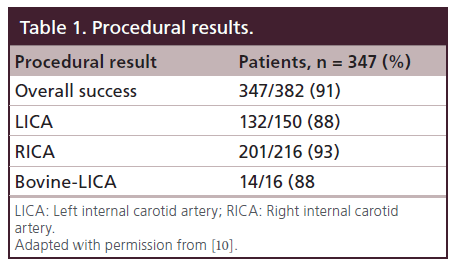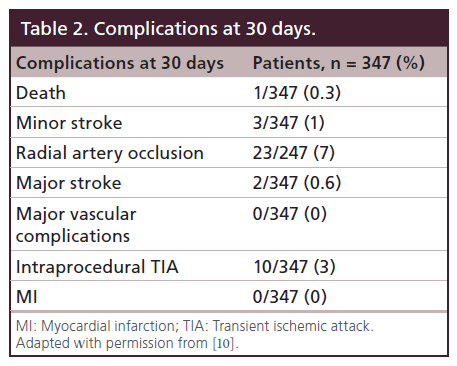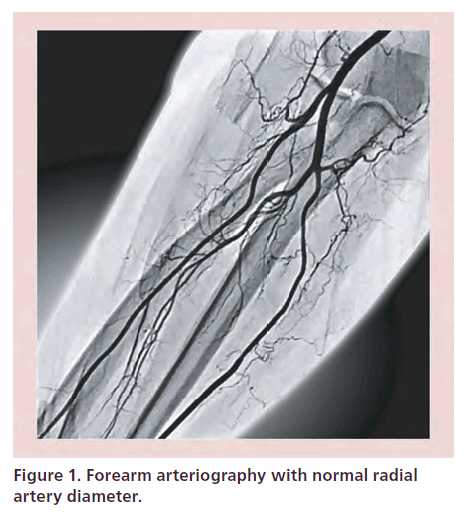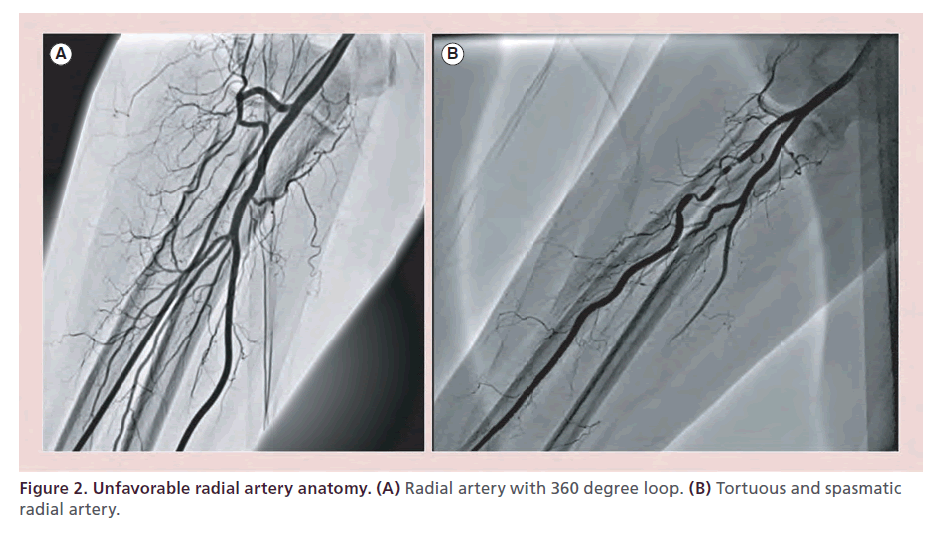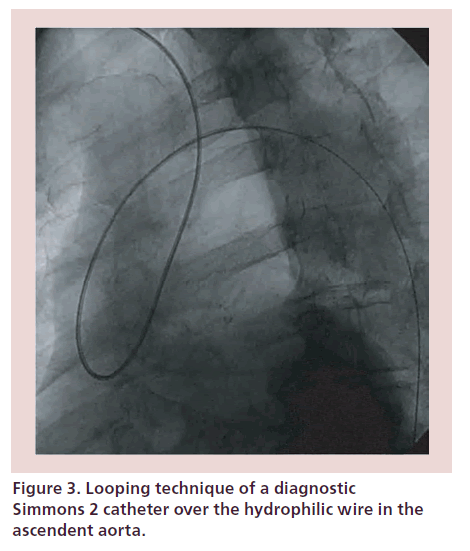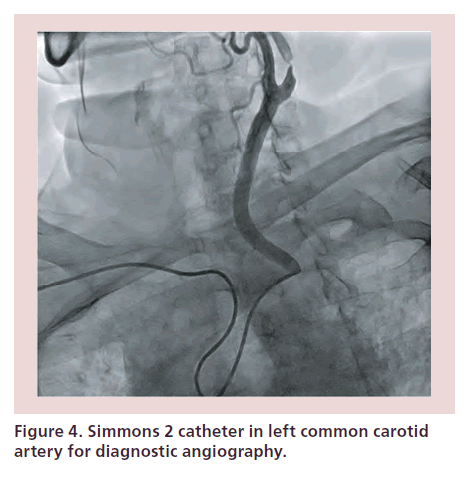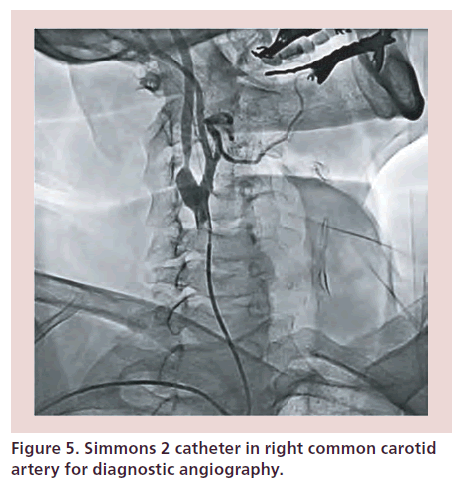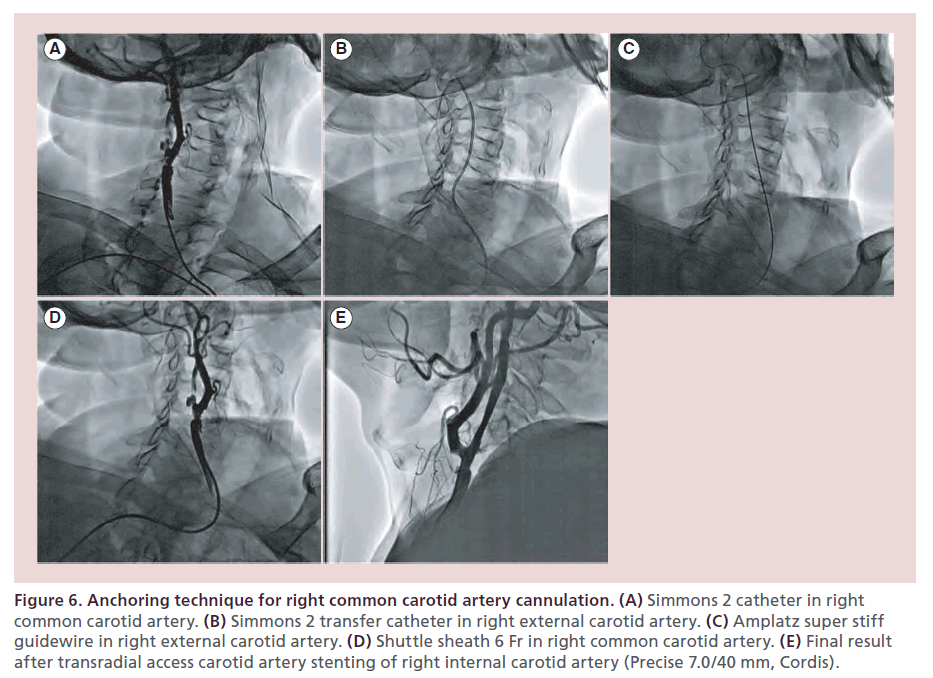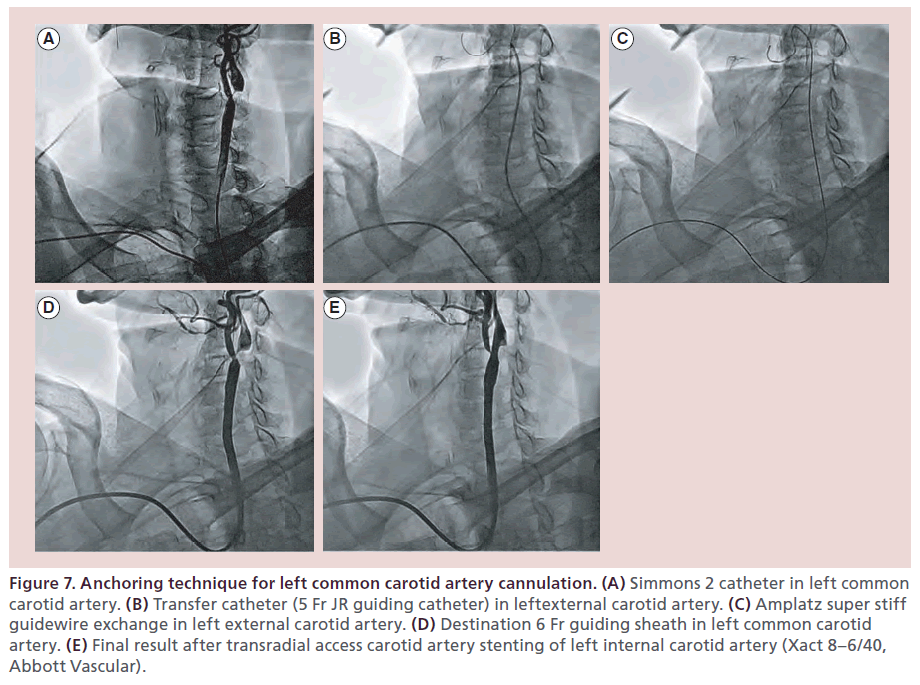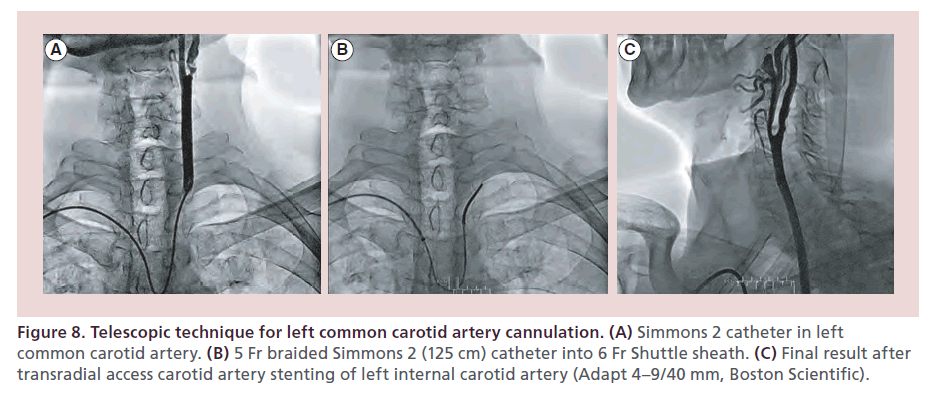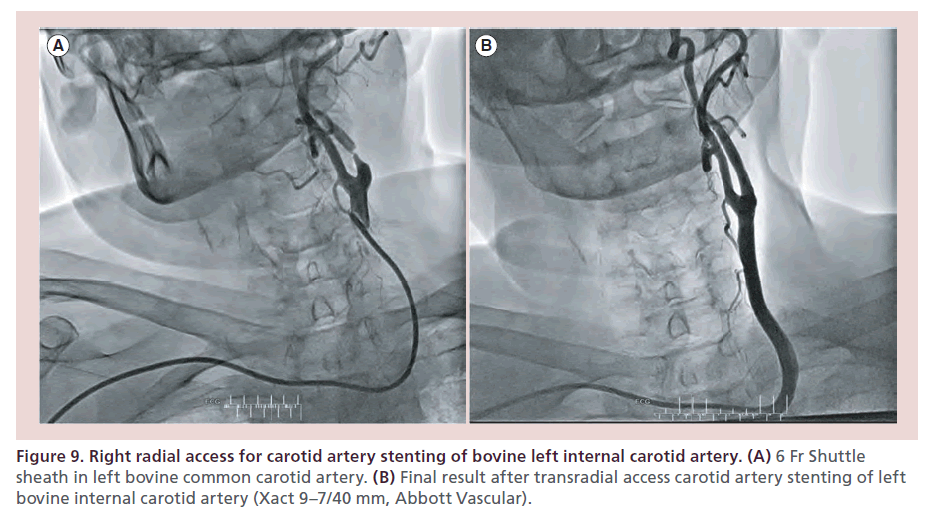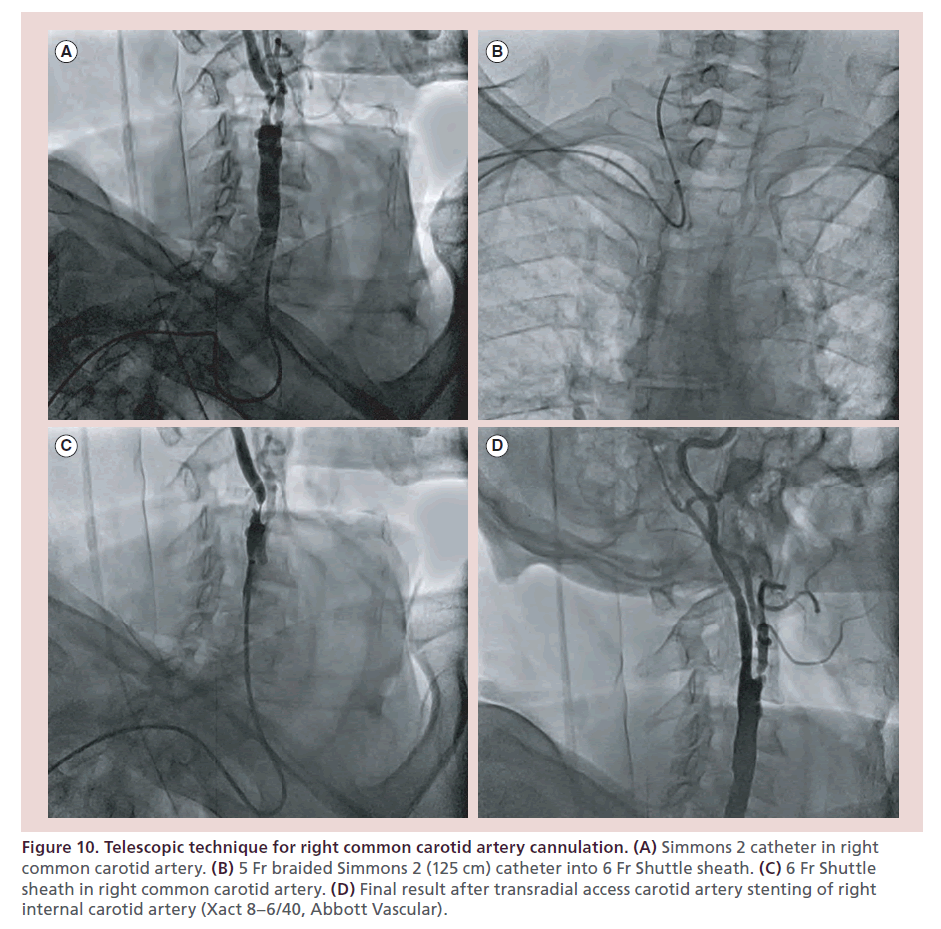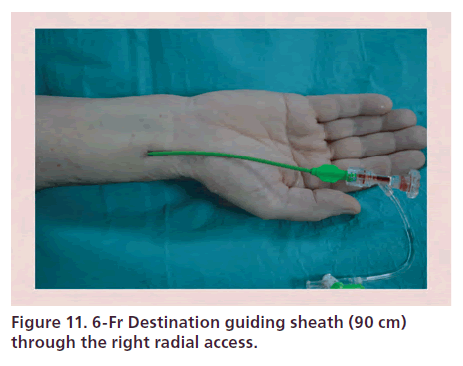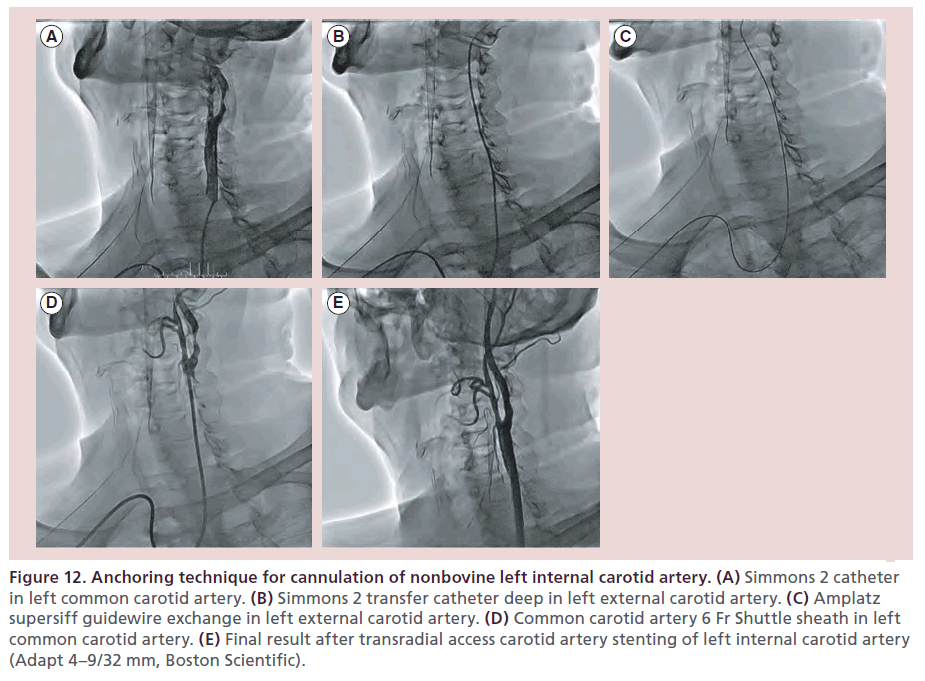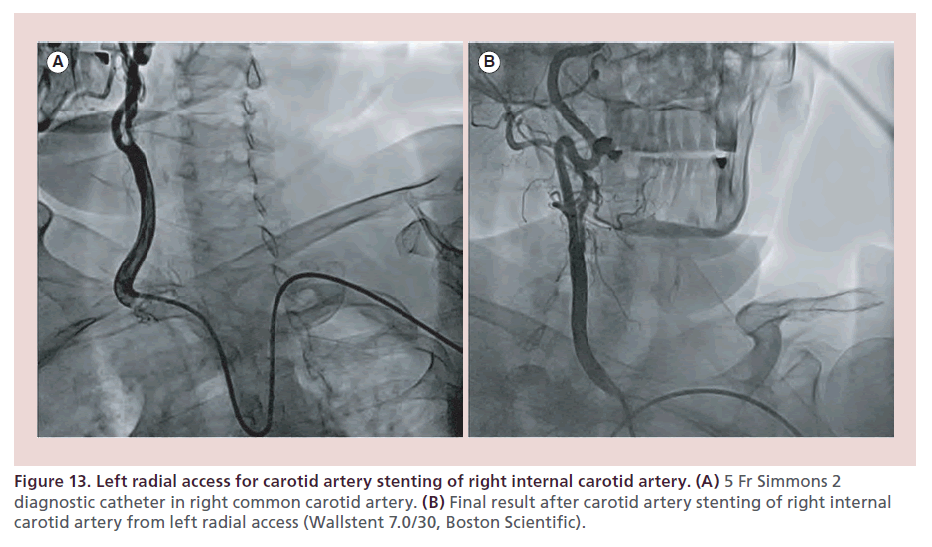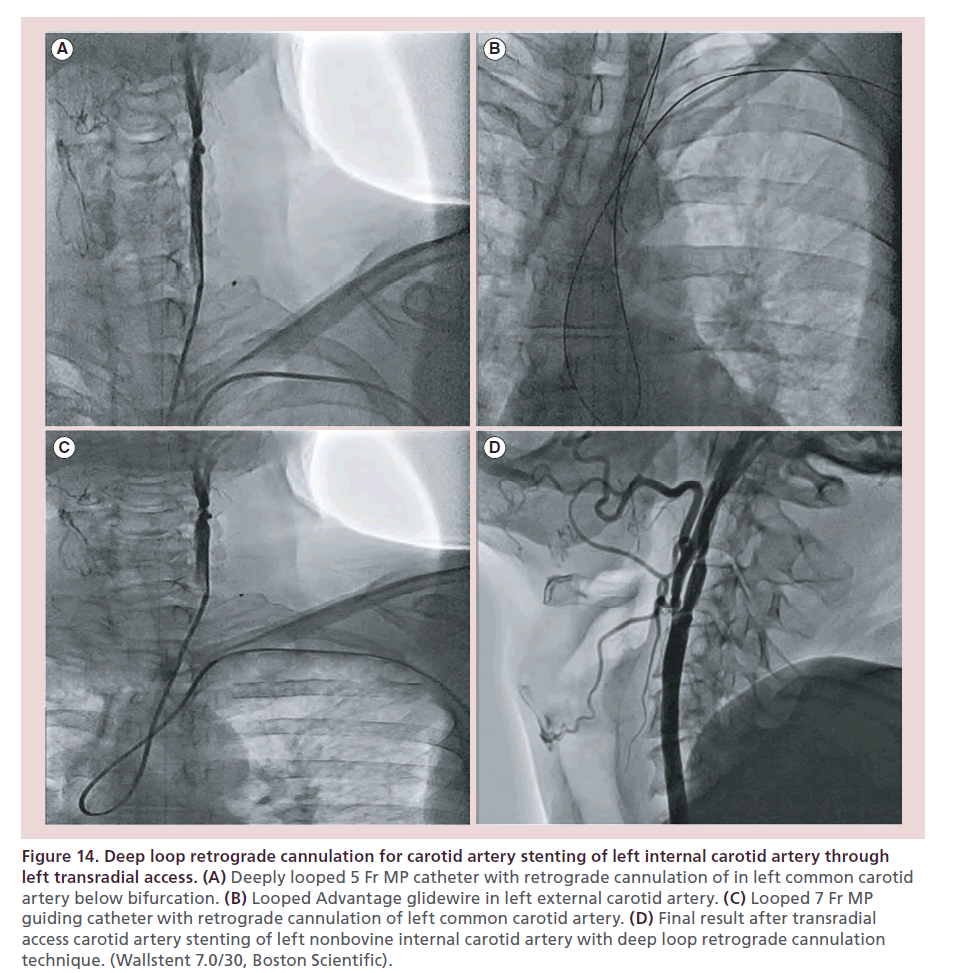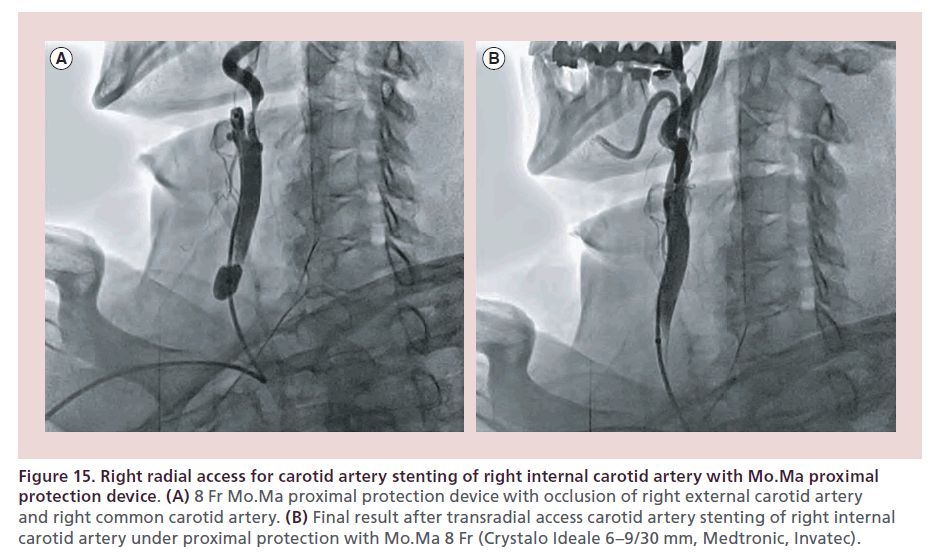Review Article - Interventional Cardiology (2014) Volume 6, Issue 5
Transradial carotid artery stenting: examining the alternatives when femoral access is unavailable
- Corresponding Author:
- Sasko Kedev
Department of Cardiology, Medical Faculty,
University Clinic of Cardiology,
University of St Cyril & Methodius,
Vodnjanska 17, Skopje, Macedonia
Tel: +389 23113116
Fax: +389 23164134
E-mail: skedev@gmail.com
Abstract
Carotid artery stenting with embolic protection has been shown to be a proven alternative to carotid endarterectomy in patients with significant carotid disease. The transfemoral approach is the conventional access site for carotid stenting. Access site complications are the most common adverse event after carotid stenting from the femoral access and most technical failures are related to a complex aortic arch. As demonstrated in multiple studies, transradial approach reduces access site bleeding and vascular complications in coronary interventional procedures. It may offer a more direct and safer approach in cases involving a complex arch. Previous feasibility studies and case reports have demonstrated that transradial access may be a viable alternative strategy in these patients.
Carotid artery stenting with embolic protection has been shown to be a proven alternative to carotid endarterectomy in patients with significant carotid disease. The transfemoral approach is the conventional access site for carotid stenting. Access site complications are the most common adverse event after carotid stenting from the femoral access and most technical failures are related to a complex aortic arch. As demonstrated in multiple studies, transradial approach reduces access site bleeding and vascular complications in coronary interventional procedures. It may offer a more direct and safer approach in cases involving a complex arch. Previous feasibility studies and case reports have demonstrated that transradial access may be a viable alternative strategy in these patients.
Keywords
CAS, carotid artery stenting, transfemoral approach, TFA, transradial approach, TRA, TRA CA, transradial carotid angiography
Carotid artery stenting (CAS) when performed by experienced operators using embolic protection, has emerged as an alternative to carotid endarterectomy in patients with significant carotid disease [1–5]. Transfemoral approach (TFA) is the conventional access site for carotid stenting. However, this approach may be problematic due to peripheral vascular disease and numerous anatomical variations of the aortic arch and cervical arteries. Thus, transradial access (TRA) has been evaluated as an alternative strategy for CAS.
The most common adverse event after CAS from TFA are access site bleeding and vascular complications. In the CREST trial, the need for transfusion was significantly associated with a stroke [6]. Elimination of these access site bleeding complications with TRA is well documented in patients undergoing coronary interventions.
Most technical failures of CAS from the TFA are related to a complex aortic arch. The highest risk features for CAS complications are friable aortic arch atheromas in patients with type III aortic arch [7]. The symptomatic strokes (14%) contralateral to the vascular territory of the treated carotid stenosis is strongly indicative that catheter manipulations in aortic arch is a cause of atheroembolic brain lesions [6,8]. The highest prevalence of atherosclerosis distribution is in the descending aorta (38.2%), followed by arch (27.6%) distal to the innominate artery, especially with increasing age [9].
The use of TRA may minimize catheter contact with the arch and thereby reduce stroke risk, particularly in cases of CAS involving the right internal carotid artery (ICA) or bovine left ICA.
Previous case reports and feasibility studies have demonstrated that with careful technique, TRA CAS can be successfully performed by experienced operators with a low complication rate in a high percentage of patients (Tables 1 & 2) [10]. In addition, TRA for CAS may be useful in patients with severe peripheral vascular disease, high risk for bleeding and vascular complications (female, obese, elderly) and those with a contraindication for prolonged postprocedure bed rest [10–26]. Early patient mobilization is an important benefit of this approach.
The transradial technique for carotid stenting involves several different methods for the basic anatomical types of carotid disease: right ICA, bovine left ICA and nonbovine left ICA. The purpose of this review is to describe the preferred technical transradial strategy for CAS in various types of aortic arch and carotid anatomy.
Transradial access
Right radial access is the preferred approach in most cases. The optimal access site is 2 cm proximal to the styloid process of the radius bone along the axis with the most powerful pulsation of the radial artery (RA). With counter-puncture technique, a 20-G plastic cannula-over-needle (Glidesheath insertion kit, Terumo, Tokyo, Japan) is inserted at a 30–60° angle along the vessel axis using. When good arterial ‘back bleed’ is obtained, the 0.025” hydrophilic guidewire is advanced and the hydrophilic 5 Fr sheath (Radifocus, Terumo, Tokyo, Japan) introduced over the guidewire.
Intra-arterial vasodilator (5 mg verapamil) is injected through the sheath to reduce radial artery spasm (RAS). Sedation may occasionally be necessary in extremely anxious patients as circulating catecholamines can precipitate RAS. Intravenous unfractionated heparin (UH) (50–70 μ/kg, up to 5000 units) or weight-based bivalirudin is administered immediately after sheath insertion.
Forearm angiography is performed through the cannula or sheath, before catheter insertion (Figure 1). This important step defines the RA anatomy from mid forearm to brachial/axilar anastomosis and provide roadmap for secured access. A diluted solution of 3 ml of contrast mixed with 7 ml of blood is injected briskly and fluoroscopy recorded (Figure 1).
In cases with RAS, tortuosity and/or radial loops and high take-off RA, a 0.014” soft coronary guidewire can be used under fluoroscopy guidance. In most cases these anatomical variations may be negotiated for diagnostic carotid arteriography. However, patients with unfavorable RA anatomy (severe tortuosities, significant 360 degree RA loops and high take-off small calibre RA) should be avoided when large bore devices are considered. (Figure 2A & B).
In patients with previous RA catheterization and known forearm anatomy, high puncture of RA can be attempted.
Transradial carotid angiography
The use of noninvasive imaging (magnetic resonance angiography or computed tomographic angiography) should be individualized. Prior to the stent procedure, a complete evaluation of the aortic arch as well as bilateral carotid arteriography is required. In most patients with right internal carotid disease, a right anterior oblique angiogram of the innominate bifurcation should be evaluated. Initial angiography is performed through a 4- or 5-Fr diagnostic catheter. The specific curve of the diagnostic catheter is based on the type of arch and common carotid artery (CCA) take-off. Thus, different diagnostic catheters can be utilized for right ICA, bovine left ICA and nonbovine left ICA.
Most frequently, a reversed angle catheter, such as Simmons type 1 or 2, are primarily used for TRA carotid angiography (Terumo, Tokyo, Japan; Merit Medical, Galway, Ireland; Cordis Corporation, Warren NJ, USA). There are two methods of reforming the natural reversed curve of the Simmons catheters within the aortic arch. The first simply involves passing the catheter over a hydrophilic glidewire looped in the ascending aorta. This technique is used for a Simmons 1 or a Simmons 2 catheter in patients with a very tortuous and dilated aortic arch (Figure 3).
The second method is preferred for the Simmons 2 catheter in most cases. The catheter is negotiated into the descending thoracic aorta over a standard guidewire. The curve is reformed by withdrawing the guidewire into the primary curve and prolapsing the catheter into the ascending aorta with counterclockwise rotation. Sometimes, patient should take and hold a deep breath in order to facilitate catheter reformation in the ascending aorta.
With this maneuver the catheter forms a loop on itself, which often directly engages the left carotid. After angiography of the left carotid, catheter should be pushed, rotated and can be withdrawn into the right common carotid (Figures 4 & 5) [27]. The Simmons 2 catheter should be used with caution in the right common carotid of women and short patients as the distal limb may reach the bifurcation. Catheters with soft reversed angle tip are the most easily reformable and the least traumatic during diagnostic carotid angiography (Merit Medical, Galway, Ireland).
Techniques of CCA cannulation
Preprocedural imaging (CT/MRI angiography, aortography) of the aortic arch and take-off angulation of the supra-aortic arteries determine the preferred technique of carotid cannulation.
There are two different modes of CCA cannulation: anchoring and telescopic technique.
TRA for CAS is usually performed through a 5- or 6-Fr long (90 cm) Shuttle Sheath (Cook, Minneapolis, MN, USA), Destination Sheath (Terumo, Tokyo, Japan) or Sheathless PV Guiding System (Asahi Intecc, Aichi, Japan) inserted using a variation of the standard femoral technique. Alternatively, conventional guiding catheters (6–8 Fr) might be used. Compatibility with the guiding sheath diameter is determined by the RA size based on preprocedural radial angiography.
Anchoring technique
For the anchoring technique, the diagnostic catheter initially passes into the external carotid artery (ECA) over a 0.035’‘ glidewire. Usually, a diagnostic or transfer catheter positioned in the ECA is used for insertion of an exchange length, more supportive guidewire over which a guiding sheath is deployed (Figure 6).
Figure 6. Anchoring technique for right common carotid artery cannulation. (A) Simmons 2 catheter in right common carotid artery. (B) Simmons 2 transfer catheter in right external carotid artery. (C) Amplatz super stiff guidewire in right external carotid artery. (D) Shuttle sheath 6 Fr in right common carotid artery. (E) Final result after transradial access carotid artery stenting of right internal carotid artery (Precise 7.0/40 mm, Cordis).
Guidewire selection for sheath deployment is based on several factors including the specific carotid involved, aortic arch type and other anatomical considerations. The same technique can be used for insertion of regular guiding catheters (6–8 Fr) or sheathless catheters (Figure 7).
Figure 7. Anchoring technique for left common carotid artery cannulation. (A) Simmons 2 catheter in left common carotid artery. (B) Transfer catheter (5 Fr JR guiding catheter) in leftexternal carotid artery. (C) Amplatz super stiff guidewire exchange in left external carotid artery. (D) Destination 6 Fr guiding sheath in left common carotid artery. (E) Final result after transradial access carotid artery stenting of left internal carotid artery (Xact 8–6/40, Abbott Vascular).
Telescopic approach
With the telescopic technique, a long (125 cm) wirebraided Simmons 2 catheter (Cook, MN, USA) is positioned within the shuttle sheath and is used as the introducer. This technique is useful for sheath deployment in cases with extreme angles, such as nonbovine left carotid or sharp take-off of right CCA (Figure 8).
Figure 8. Telescopic technique for left common carotid artery cannulation. (A) Simmons 2 catheter in left common carotid artery. (B) 5 Fr braided Simmons 2 (125 cm) catheter into 6 Fr Shuttle sheath. (C) Final result after transradial access carotid artery stenting of left internal carotid artery (Adapt 4–9/40 mm, Boston Scientific).
Insertion of the sheath or guiding catheter from TRA necessarily involves acute angles that must be negotiated. Different strategies for sheath deployment (direct cannulation, simple loop and deep loop retrograde cannulation) are related to the severity of the angle between the arm and CCA. In general, the different strategies vary according to the basic carotid artery classifications: right, bovine left and nonbovine left subgroups.
Direct cannulation
Since many procedurally related strokes originate from arch atheroembolization, the use of TRA may minimize catheter contact with the aortic arch, and thereby reduce stroke risk. The use of TRA in CAS of right ICA and bovine left ICA in particular are associated with minimal catheter contact with the aortic arch and consequently with reduced risk of atheroembolization.
An right anterior oblique angiogram or preprocedural CT of the innominate (brachiocephalic) artery bifurcation is useful in determining the right ICA sheath insertion strategy. With less acute angles, especially when a horizontal segment of the subclavian or common carotid is present, direct cannulation with right Judkins or internal mammary catheter is feasible. The original technique of right ICA stenting involves passing the Simmons 1 or 2 catheter into the ECA over a glidewire. An exchange length extrasupport 0.035” J wire is then inserted and serves as the platform for sheath deployment.
The bovine arch in which the right brachiocephalic and left carotid share a common trunk from the aortic arch occurs in around 13% of population [28]. The right transradial approach may be the preferred strategy for carotid stenting of left ICA stenosis with bovine arch anatomy.
The initial take-off of the bovine carotid is evaluated using an left anterior oblique aortic arch arteriogram. Frequently, no specific maneuvers are needed since wires and catheters usually tend to spontaneously go into the left CCA. When the initial segment of the common carotid is horizontal, a Judkins right or Amplatz R2 diagnostic catheter is suitable (Figure 9).
The ECA can often be directly cannulated with the hybrid 0.035” Advantage (distal tip hydrophilic glidewire with stiffer nitinol core on the proximal end, Terumo; Tokyo, Japan) thus omitting the step of passing the diagnostic catheter into the external carotid artery.
Simple loop cannulation
When the angle of take-off of the right common carotid is vertical or acute, a wire braided Simmons 2 catheter positioned close to the bifurcation is used. The catheter is passed into the external over a glidewire or extra support coronary wire and then exchanged for the shuttle sheath. In this situation, an Amplatz superstiff guidewire to deploy the sheath may be necessary. When the angle of take-off of the right common carotid is particularly severe, a telescopic technique with the long (125 cm) Simmons 2 wire-braided catheter inside the shuttle sheath can also be utilized (Figure 10). Generally, right radial access provides adequate support even in acute angles of the CCA with the arch of the aorta.
Figure 10. Telescopic technique for right common carotid artery cannulation. (A) Simmons 2 catheter in right common carotid artery. (B) 5 Fr braided Simmons 2 (125 cm) catheter into 6 Fr Shuttle sheath. (C) 6 Fr Shuttle sheath in right common carotid artery. (D) Final result after transradial access carotid artery stenting of right internal carotid artery (Xact 8–6/40, Abbott Vascular).
TRA for nonbovine left internal carotid disease is more challenging due to the unfavorable take-off of the left common carotid [10–12]. The acute angle results in poor inferior support for the catheter system with resulting tendency for catheters to prolapse into the ascending aorta. This problem is particularly ominous should prolapse occur during stent delivery.
The use of a wire-braided Simmons 2 catheter with its relatively long distal end provides adequate support for passing a guidewire into the ECA in the majority of cases. A Simmons 3 catheter provides even more support and is utilized in cases of type II and type III arches with particularly acute angles of take-off of the common carotid. The anchoring technique with a stepwise exchange of glidewire, Advantage and Amplatz superstiff through the diagnostic catheter in the ECA are most commonly utilized.
With extreme angles, a 5- or 6-Fr multipurpose or Judkins R guide catheter can be used as an intermediate transfer catheter to insert an Amplatz superstiff guidewire. In these extreme situations, kinking of the shuttle sheath may occur at the acute angle and a heavily braided, semihydrophilic Destination sheath (Terumo, Tokyo, Japan) should be substituted to provide maximum support (Figures 11 & 12).
Figure 12. Anchoring technique for cannulation of nonbovine left internal carotid artery. (A) Simmons 2 catheter in left common carotid artery. (B) Simmons 2 transfer catheter deep in left external carotid artery. (C) Amplatz supersiff guidewire exchange in left external carotid artery. (D) Common carotid artery 6 Fr Shuttle sheath in left common carotid artery. (E) Final result after transradial access carotid artery stenting of left internal carotid artery (Adapt 4–9/32 mm, Boston Scientific).
Generally, a telescopic approach with a wire-braided 125-cm-long Simmons 2 diagnostic catheter within the guiding sheath is preferred in cases of nonbovine left ICA lesions.
Patel et al. have proposed the left radial approach for right internal carotid stenting [12]. With this technique, the right CCA is selected from the left RA using a Tiger or Simmons 2 catheter. The diagnostic catheter is then passed into the ECA or high CCA and a 5- or 6-Fr shuttle sheath or 7-Fr guiding catheter passed over a 0.035” superstiff guidewire (Figure 13).
Figure 13. Left radial access for carotid artery stenting of right internal carotid artery. (A) 5 Fr Simmons 2 diagnostic catheter in right common carotid artery. (B) Final result after carotid artery stenting of right internal carotid artery from left radial access (Wallstent 7.0/30, Boston Scientific).
After positioning the guiding sheath or guiding catheter beneath the bifurcation in the target carotid artery, CAS with distal embolic protection is performed in usual fashion.
Deep loop retrograde cannulation
The Catheter Looping and Retrograde Engagement Technique (CLARET) is an alternative strategy that has been described by Fang et al. [13]. The unique feature of this technique is the use of the right coronary cusp to provide inferior support for the system (Figure 14). With this technique, a 7-Fr MP guide catheter can be used for CAS of both right ICA and left ICA with unfavorable take-off angulations. The main disadvantage is the system instability with continuous movement of the guiding catheter and the filter. Particular attention should be made during guiding catheter removal since it could jump distally during pull back.
Figure 14. Deep loop retrograde cannulation for carotid artery stenting of left internal carotid artery through left transradial access. (A) Deeply looped 5 Fr MP catheter with retrograde cannulation of in left common carotid artery below bifurcation. (B) Looped Advantage glidewire in left external carotid artery. (C) Looped 7 Fr MP guiding catheter with retrograde cannulation of left common carotid artery. (D) Final result after transradial access carotid artery stenting of left nonbovine internal carotid artery with deep loop retrograde cannulation technique. (Wallstent 7.0/30, Boston Scientific).
Transradial CAS with proximal protection device
Major limitation of TRA in endovascular procedures is related to the size of the devices to be used, although feasibility of using 8 Fr sheaths in the RA has already been demonstrated [29]. Proximal embolic protection devices (PPDs) are increasingly used during CAS due to the theoretical advantage of cerebral protection during the entire procedure. Two small studies suggested that PPDs are superior to distal filters for reducing surrogate end points of cerebral embolism [30,31].
PPDs are larger and cumbersome devices (8 or 9 Fr) which need specific training to become familiar with. They consist in a long sheath, with a central working lumen, connected to two balloons inflated to occlude the ECA and the CCA, allowing cerebral protection during all steps of CAS. Trani et al., reported the first three cases of transradial CAS using 8 Fr proximal protection with Mo.Ma device (Medtonic Invatec, Roncadelle, Italy) [17]. We successfully used the Mo.Ma device recently during 15 transradial CAS procedures (eight left ICA and seven right ICA) [Kedev S, Pers. Comm.].
The anchoring technique is used for deployment over the 0.035” supperstiff supportive guidewire positioned in the corresponding ECA. The inflated occluding balloons in ECA and in CCA, with extrasupportive 0.014” guidewire can provide additional stability of the whole guiding system, particularly important in cases with more angulated CCA take off (Figure 15A & B). However, CAS with Mo.Ma device by TRA should be regarded as a challenging procedure which requires significant operator experience in both radial approach and carotid interventions.
Figure 15. Right radial access for carotid artery stenting of right internal carotid artery with Mo.Ma proximal protection device. (A) 8 Fr Mo.Ma proximal protection device with occlusion of right external carotid artery and right common carotid artery. (B) Final result after transradial access carotid artery stenting of right internal carotid artery under proximal protection with Mo.Ma 8 Fr (Crystalo Ideale 6–9/30 mm, Medtronic, Invatec).
Arterial sheath management
This incidence of RA occlusion following TRA CAS is relatively high and is at least in part related to the use of large bore catheters [32]. Contemporary RA preservation techniques, especially the application of hemostasis devices using patent hemostasis, may reduce this complication [33,34].
Radial sheath is removed immediately after the procedure and hemostasis is achieved usually by TR band compression (Terumo, Tokyo, Japan), by inflating 15–18 ml of air at the puncture site. Pulse oximetry is used to confirm that hemoglobin oxygen saturation is more than 90% on the involved hand after hemostasis is obtained. Compression is applied for approximately 2–3 h period (depending on the sheath size) with gradual relaxation of compression after the first hour.
Patients are usually discharged the following day after a careful examination by the attending physician.
Limitations
Several important limitations are associated with this approach. Extensive experience with both the transradial approach and CAS is necessary. The transradial learning curve may limit the implementation of the described techniques. The impact of the interventionalist’s learning curve on outcomes has been well-established both for carotid stenting and transradial PCI; it is therefore likely that a procedure that combines these two skills may further steepen the learning curve [3,4].
The assessment of appropriate RA size and anatomy with preliminary angiography is fundamental. Patients with unfavorable anatomy such as significant tortuosity, loops or other anatomic variants should not be considered for use of large-sized devices.
There are some technical caveats. The potential problem of air embolization caused by the use of bulky stents in small sheaths can be eliminated with awareness and careful de-aering technique. Stents should be positioned using roadmap fluoroscopy or bony landmarks. Contrast injections are made only after careful bleed-back. Reforming 5 Fr Simmons curves may be problematic, and manipulations are minimized by using the looping technique [27].
Even though, all commercially available stents and distal embolic protection devices can be utilized transradially, only the carotid Wallstent, Adapt (Boston Scientific, Maple Grove, MN, USA), Precise (Cordis Corporation, Warren NJ, USA) and Crystalo Ideale (Medtonic, Invatec, Roncadelle, Italy) can be delivered though 5 Fr sheaths and through 6 and 7 Fr guiding catheters.
Conclusion
TRA is an attractive alternative approach in patients undergoing carotid stenting. It is particularly indicated in patients with extensive peripheral vascular disease and patients with anatomical variations that make cannulation of the common carotid difficult from the femoral approach. Furthermore, an important benefit of the transradial approach is reduction of bleeding and vascular complications in obese, female and the elderly population undergoing these procedures. The use of the radial approach in patients with right internal carotid disease and bovine left internal carotid disease also offers the advantage of possibly reducing catheterinduced embolization from the arch since transradial catheters do not traverse this area. Previous experience in the transradial approach is very important as these are advanced techniques. New operators are encouraged to be comfortable with transradial cerebrovascular angiography before undertaking transradial carotid stenting procedures.
Finally, the feasibility, safety and success of the transradial approach in CAS has been demonstrated. With careful technique and experienced operators, the procedure can be performed with a low complication rate.
Future perspective
Although the feasibility and success of TRA CAS procedures with the currently available equipment has been demonstrated, future technological advances should improve the general applicability of the technique. Flexible and more supportive sheath would be useful in patients with the most acute angles at the origin of the common carotid as lack of inferior support is the cause of most failures. Guiding catheters with dedicated carotid curves could facilitate direct common carotid cannulation. The development of lower profile, more deliverable stent systems is imperative. Currently, four carotid stents can be deployed through a 5 Fr sheath, only two of which are available in the United States. Smaller catheter systems would not only improve deliverability but also reduce RA injury and occlusion.
Financial & competing interests disclosure
The author has no relevant affiliations or financial involvement with any organization or entity with a financial interest in or financial conflict with the subject matter or materials discussed in the manuscript. This includes employment, consultancies, honoraria, stock ownership or options, expert testimony, grants or patents received or pending or royalties.
No writing assistance was utilized in the production of this manuscript.
Executive summary
Advantages of transradial access carotid artery stenting
• Alternative access in patients with extensive peripheral vascular disease.
• Reduction of access site bleeding and vascular complications in female, obese and elderly population.
• Alternative access in patients with anatomical variations that make cannulation of the common carotid difficult from the femoral approach.
• The preferred approach in patients with bovine left internal carotid artery (ICA) disease. The use of the transradial access (TRA) in patients with right ICA disease and bovine left ICA disease may reduce catheterinduced embolization from the transverse aortic arch [35–38].
• Reduced hypotensive response after carotid artery stenting (CAS).
• Early patient mobilization.
• Reduced nursing cost.
Disadvantages of transradial access carotid artery stenting
• Extensive experience with both the transradial approach and CAS is necessary.
• Significant learning curve for new transradial operators.
• Sometimes longer procedure for easy transfemoral approach cases with type I aortic arch.
• Proximal protection and larger devices cannot be used freely in all cases.
• Postprocedure radial artery occlusion.
References
Papers of special note have been highlighted as: • of interest; •• of considerable interest
- Brott TG, Hobson RW 2nd, Howard G et al. Stenting versus endarterectomy for treatment of carotid artery stenosis. N. Engl. J. Med. 363, 11–23 (2010).
- Silver FL, Mackey A, Clark WM et al. Safety of stenting and endarterectomy by symptomatic status in the carotid revascularization endarterectomy versus stenting trial (CREST). Stroke 42, 675–680 (2011).
- Gray WA, Yadav JS, Verta P et al. The CAPTURE registry: predictors of outcomes in carotid artery stenting with embolic protection for high surgical risk patients in the early post-approval setting. Catheter. Cardiovasc. Interv. 70, 1025–1033 (2007).
- Gurm HS, Yadav JS, Fayad P et al. Long-term results of carotid stenting versus endarterectomy in high-risk patients. N. Engl. J. Med. 358 , 1572–1579 (2008).
- White CJ, Iyer SS, Hopkins LN, Katzen BT, Russell ME. BEACH trial investigators. Carotid stenting with distal protection in 4 high surgical risk patients: the BEACH trial 30 day results. Catheter. Cardiovasc. Interv. 67, 503–512 (2006).
- Hill MD, Brooks W, Mackey A et al. Stroke after carotid stenting and endarterectomy in the Carotid Revascularization Endarterectomy Versus Stenting Trial (CREST). Circulation 126, 3054–3061 (2012).
- Macdonald S, Lee R, Williams R, Stansby G. Delphi Carotid Stenting Consensus Panel. Towards safer carotid artery stenting: a scoring system for anatomic suitability. Stroke 40, 1698–1703 (2009).
- Hammer FD, Lacroix V, Duprez T et al. Cerebral microembolization after protected carotid artery stenting in surgical high-risk patients: results of a 2-year prospective study. J. Vasc. Surg. 42, 847–853 (2005).
- Meissner I, Whisnant JP, Khandheria BK et al. Prevalence of potential risk factors for stroke assessed by transesophageal echocardiography and carotid ultrasonography: the SPARC study. Stroke Prevention: Assessment of Risk in a Community. Mayo. Clin. Proc. 74, 862–869 (1999).
- Etxegoien N, Rhyne D, Kedev S, Sachar R, Mann T. The transradial approach for carotid artery stenting. Catheter. Cardiovasc. Interv. 80, 1081–1087 (2012).
- Folmar J, Sachar R, Mann T. Transradial approach for carotid artery stenting: a feasibility study. Catheter. Cardiovasc. Interv. 63 (3), 355–361 (2007).
- Patel T, Shah S, Ranian A et al. Contralateral transradial approach for carotid artery stenting: a feasibility study. Catheter. Cardiovasc. Interv. 75, 268–275 (2009).
- Fang H, Chung S, Sun C et al. Transradial and transbrachial arterial approach for simultaneous carotid angiographic examination and stenting using catheter looping and retrograde engagement technique. Ann. Vasc. Surg. 24, 670–679 (2010).
- Mendiz OA, Sampaolesi AH, Londero HF et al. Initial experience with transradial access for carotid stenting. Vasc. Endovascular Surg. 45, 499–503 (2011).
- Pinter L, Cagiannos C, Ruzsa Z, Bakoyiannis C, Kolvenbach R. Report on initial experience with transradial access for carotid artery stenting. J. Vasc. Surg. 45, 1136–1141 (2007).
- Bakoyiannis C, Economopoulos KP, Georgopoulos S et al. Transradial access for carotid artery stenting: a single center experience. Int. Angiol. 29, 41–46 (2010).
- Trani C, Burzotta F, Coroleu F. Transradial carotid artery stenting with proximal embolic protection. Catheter. Cardiovasc. Interv. 74, 267–272 (2009).
- Coroleu SF, Burzotta F, Fernández-Gómez C et al. Feasibility of complex coronary and peripheral interventions by trans- radial approach using large sheaths. Catheter. Cardiovasc. Diagn. 79, 597–600 (2011).
- Shaw JA, Gravereaux EC, Eisenhauer AC. Carotid stenting in the bovine arch. Catheter. Cardiovasc. Interv. 60, 566–569 (2003).
- Gan HW, Bhasin A, Wu CJ. Transradial carotid stenting in a patient with bovine arch anatomy. Catheter. Cardiovasc. Interv. 75, 540–543 (2006).
- Levy EI, Kim SH, Bendok BR et al. Transradial stenting of the cervical internal carotid artery: technical case report. Neurosurgery 53, 448–451 (2003).
- Layton KF, Kallmes DF, Cloft HJ. The radial artery access site for interventional neuroradiology procedures. Am. J. Neuroradiol. 27, 1151–1154 (2006).
- Bendok BR, Przybylo JH, Parkinson R et al. Neuroendovascular interventions for intracranial posterior circulation disease via the transradial approach: technical case report. Neurosurgery 56, e626 (2005).
- Eskioglu E, Burry MV, Mericle RA. Transradial approach for neuroendovascular surgery of intracranial vascular lesions. J. Neurosurg. 101, 767–769 (2004).
- Castriota F, Cremonesi A, Manetti R, Lamarra M, Noera G. Carotid stenting using radial artery access. J. Endovasc. Surg. 6, 385–386(1999).
- Yoo BS, Lee SH, Kim JY et al. A ase of transradial carotid stenting in a patient with total occlusion of distal abdominal aorta. Catheter. Cardiovasc. Interv. 56, 243–245 (2002).
- Lee D, Ahn J, Jeong S et al. Routine transradial access for conventional cerebral angiography: a single operator’s experience of its feasibility and safety. Br. J. Radiol. 77, 831–838 (2004).
- Layton KF, Kallmes DF, Cloft HJ et al. Bovine aortic arch variant in humans: clarification of a common misnomer. Am. J. Neuroradiol. 27, 1541–1542 (2006).
- Wu SS, Galani RJ, Bahro A et al. 8 French transradial coronary interventions: clinical outcome and late effects on the radial artery and hand function. J. Invasive Cardiol. 12, 605–609 (2000).
- Montorsi P, Caputi L, Galli S et al. Microembolization during carotid artery stenting in patients with high-risk, lipid rich plaque: A randomized trial of proximal versus distal cerebral protection. J. Am. Coll. Cardiol. 58, 1656–1663 (2012).
- Bijuklic K, Wandler A, Hazizi F et al. The PROFI Study (prevention of cerebral embolization by proximal balloon occlusion compared with filter protection during carotid artery stenting): a prospective randomized trial. J. Am. Coll. Cardiol. 59, 1383–1391 (2012).
- Saito S, Ikei H, Hosokawa G, Tanaka S. Influence of the ratio between radial artery inner diameter and sheath outer diameter on radial artery flow after transradial coronary intervention. Cathet. Cardiovasc. Intervent.46, 173–178 (1999).
- Pancholy S, Coppola J, Patel T et al. Prevention of radial artery occlusion – patient hemostasis evaluation trial (PROPHET study): a randomized comparison of traditional versus patency documented hemostasis after transradial catheterization. Cathet. Cardiovasc. Intervent. 72, 335–340 (2008).
- Pancholy SB, Patel TM. Effect of duration of hemostatic compression on radial artery occlusion after transradial access. Cathet. Cardiovasc. Interv. 79, 78–81 (2012).
- Bendszur M, Koltzenburg M, Burger R et al. Silent embolism in diagnostic cerebral angiography and neurointerventional procedures: a prospective study. Lancet 354, 1594–1597 (1999).
- El-Koussy M, Schroth G, Do DD et al. Periprocedural embolic events related to carotid artery stenting detected by diffusion-weighted MRI: comparison between proximal and distal embolus protection devices. J. Endovasc. Ther. 14, 293–303 (2007).
- Barbato JE, Dillavou E, Horowitz MB et al. A randomized trial of carotid artery stenting with and without cerebral protection. J. Vasc. Surg. 47, 760–765 (2008).
- Faggioli G, Ferri M, Rapezzi C et al. Atherosclerotic aortic lesions increase the risk of cerebral embolism during carotid stenting in patients with complex aortic arch anatomy. J. Vasc. Surg. 49, 80–85 (2009).
